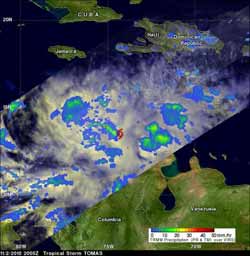NASA's TRMM satellite sees Tomas' power fluctuate

Tomas\' center of circulation wasn\'t evident when TRMM passed over Tomas on Nov. 3 at 2005 UTC (4:05 p.m. EDT) so a tropical storm symbol was overlaid to show its location. The yellow and green areas indicate moderate rainfall between .78 to 1.57 inches per hour. Credit: NASA/SSAI, Hal Pierce<br>
During the morning hours on Nov. 3, an Air Force hurricane hunter aircraft found no tropical storm force winds so Tomas was downgraded by the National Hurricane Center to a tropical depression.
At 2 p.m. EDT on Nov. 3, Tomas was undergoing some changes, and its center was re-forming farther to the northeast from where it was before. The center is now located near 14.8 North and 75.0 West, about 245 miles south-southeast of Kingston, Jamaica and 315 miles southwest of Port Au Prince, Haiti.
Maximum sustained winds were still at 35 mph, making Tomas still a depression. It was moving to the north-northwest near 7 mph and had a minimum central pressure of 1006 millibars. A turn toward the north and north-northeast is expected over the next 48 hours.
A Tropical Storm Watch has now been posted for Jamaica, and Haiti, the Dominican Republic, southeastern Cuba, the southeastern Bahamas and Turks and Caicos Islands should watch Tomas' track.
Tomas is expected to produce total rain accumulations of 5 to 10 inches over much of Haiti with possible isolated maximum amounts of 15 inches.
Tomas is now predicted to strengthen into a tropical storm and not reach hurricane strength. An upper level trough is predicted to steer a stronger Tomas through the Windward Passage between Cuba and Haiti by Friday.
Media Contact
More Information:
http://www.nasa.govAll latest news from the category: Earth Sciences
Earth Sciences (also referred to as Geosciences), which deals with basic issues surrounding our planet, plays a vital role in the area of energy and raw materials supply.
Earth Sciences comprises subjects such as geology, geography, geological informatics, paleontology, mineralogy, petrography, crystallography, geophysics, geodesy, glaciology, cartography, photogrammetry, meteorology and seismology, early-warning systems, earthquake research and polar research.
Newest articles

Machine learning algorithm reveals long-theorized glass phase in crystal
Scientists have found evidence of an elusive, glassy phase of matter that emerges when a crystal’s perfect internal pattern is disrupted. X-ray technology and machine learning converge to shed light…

Mapping plant functional diversity from space
HKU ecologists revolutionize ecosystem monitoring with novel field-satellite integration. An international team of researchers, led by Professor Jin WU from the School of Biological Sciences at The University of Hong…

Inverters with constant full load capability
…enable an increase in the performance of electric drives. Overheating components significantly limit the performance of drivetrains in electric vehicles. Inverters in particular are subject to a high thermal load,…





















